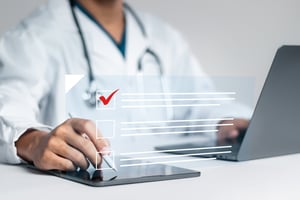In post-pandemic healthcare, medical practices are being asked to do more with less—see more...

Understanding the Value of Remote Patient Monitoring (RPM)
Remote Patient Monitoring (RPM) is changing the way care is delivered. It supports better management of chronic conditions, helps catch issues early, and reduces hospital readmissions—creating real value for patients, providers, and payors.
At Telecare USA, we’ve seen firsthand how RPM helps practices expand access, improve outcomes, and unlock new revenue streams—all while maintaining a patient-first approach.
What Is Remote Patient Monitoring?
Remote Patient Monitoring is the use of digital technologies to collect health data from patients outside of traditional healthcare settings. This data—ranging from vital signs to weight, blood pressure, blood glucose, and more—is securely transmitted to healthcare providers for assessment and action.
Instead of waiting for patients to schedule an in-person visit, RPM enables continuous, proactive monitoring that allows clinicians to intervene early and provide more personalized care.
The Value of RPM for Healthcare Providers
1. Better Clinical Outcomes
RPM enhances chronic care management by providing real-time insights that lead to quicker adjustments in treatment. For conditions like hypertension, diabetes, and heart failure, the ability to monitor patients daily leads to:
- Fewer complications
- Early detection of worsening symptoms
- Improved medication adherence
2. Increased Revenue Opportunities
RPM is reimbursed by Medicare and many commercial payors, making it financially viable for clinics of all sizes. CPT codes like 99453, 99454, and 99457 support setup, device supply, and ongoing monitoring. With the right workflows, RPM can:
- Add thousands in monthly revenue per provider
- Create scalable revenue streams tied to value-based care initiatives
At Telecare, our CPT Guarantee ensures your billing aligns with CMS requirements—no guesswork needed.
3. Enhanced Patient Engagement
When patients are actively involved in tracking their own health, they become more engaged in managing their conditions. RPM empowers them to:
- Understand their numbers
- Communicate more easily with their care team
- Feel supported even outside the clinic
Our teams provide wrap around support to ensure patients are onboarded, educated, and compliant.
The Value of RPM for Patients
1. Access to Continuous Care
For elderly or rural patients, frequent in-office visits can be difficult. RPM brings care to them, eliminating barriers such as transportation, mobility, or distance.
2. Peace of Mind
Patients know that someone is watching their health metrics and ready to intervene if anything looks off. This oversight builds trust, reduces anxiety, and enhances adherence to care plans.
3. Improved Quality of Life
By reducing unnecessary ER visits and hospitalizations, RPM allows patients to spend more time living—not waiting in clinics. It’s a proactive approach that makes healthcare feel more human.
The Value for Payors and Health Systems
1. Lower Costs, Better Outcomes
By avoiding costly hospital admissions and improving chronic condition control, RPM drives down total cost of care. In value-based care models, this leads to shared savings and stronger performance metrics.
2. Data-Driven Decision Making
RPM provides real-world evidence and trend data that support better care coordination, risk stratification, and population health strategies.
The Future of RPM: Data, Value-Based Care, and What’s Next
As the shift toward value-based care accelerates, Remote Patient Monitoring is rapidly becoming a cornerstone of modern healthcare delivery—and the numbers prove it.
RPM Adoption & Growth
- 88% of healthcare providers are investing in or considering RPM technologies as part of their long-term care strategies.
(Source: Spyglass Consulting) - The global RPM market is projected to reach $175 billion by 2027, up from just $23.2 billion in 2020.
(Source: Fortune Business Insights) - CMS has expanded RPM reimbursement codes multiple times since 2019, signaling continued federal support for remote care.
RPM & Value-Based Care
- RPM has been shown to reduce hospital readmissions by up to 76%, especially in heart failure and COPD populations.
(Source: Health Affairs, 2023) - In accountable care organizations (ACOs), practices using RPM see 20–40% improvements in key quality measures, such as blood pressure control and medication adherence.
What It Means for Your Practice
As more providers shift from fee-for-service to value-based payment models, RPM offers a practical path to:
- Increase shared savings
- Boost HEDIS and STAR ratings
- Reduce the total cost of care across populations
RPM isn’t a future innovation—it’s a present-day opportunity. And with new CPT code proposals (such as expanded chronic care coordination time tracking), the financial and clinical case for RPM has never been stronger.
Why Telecare USA?
We’ve built our platform and services around a simple idea: support providers, empower patients, and deliver measurable outcomes.
With flat-rate pricing, a hands-on support team, and a proven RPM infrastructure, Telecare helps practices implement and scale remote care programs with ease. Whether you’re a solo practice or a large medical group, we tailor solutions that fit your workflows, staff capacity, and goals.
Ready to Experience the Value of RPM?
Whether you’re new to remote monitoring or looking to optimize an existing program, Telecare is here to help you succeed. Connect with our team to schedule a personalized demo and see how RPM can elevate your practice.
Book a meeting with our team? Click here to learn more and meet with our experts!
Ready to Setup Your Clinic?
Just click the link below to talk to a member of our sales team or to learn more about our Remote Patient Monitoring solution and get your clinic started in no time.
-1.png?width=350&height=164&name=Untitled%20design%20(1)-1.png)



.jpeg?height=200&name=AdobeStock_228931381%20(2).jpeg)